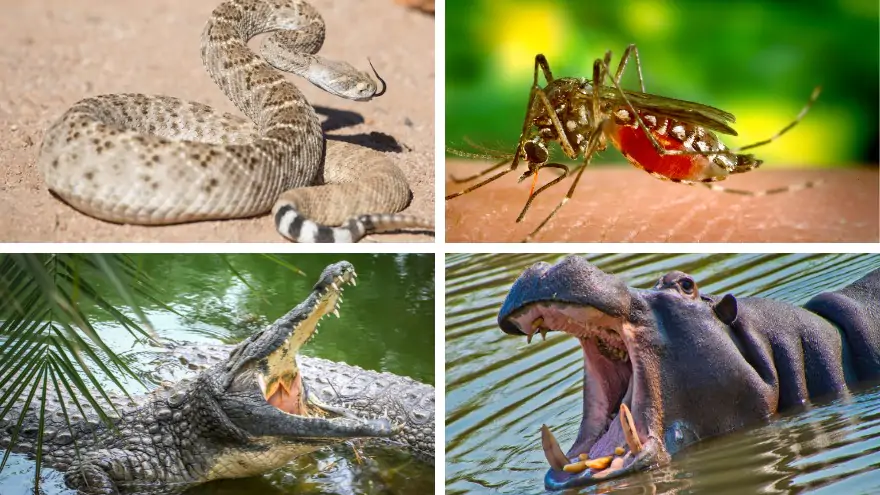Understanding the Concept of Dangerous Animals
The world is home to an incredible array of creatures, ranging from the tiny to the mighty. While many animals coexist peacefully with humans, some possess characteristics that make them exceptionally dangerous. From ferocious predators to venomous insects, nature harbors formidable threats. In this article, we will delve into the realm of the most dangerous animals, exploring their traits, behaviors, and the risks they pose to human life.
The Human Factor: Analyzing Human-Related Fatalities
Before we dive into the animal kingdom’s dangers, it is crucial to acknowledge that the most dangerous animal concerning human fatalities is, in fact, humans themselves. While other creatures might possess incredible strength or venomous weaponry, human actions, such as wars, accidents, and diseases, are responsible for the majority of deaths worldwide. It is important to remember that our own species can pose the greatest threat to our well-being.
Predatory Powerhouses: The Carnivorous Beasts
The Mighty Lion: Roaring with Dominance
In the vast African savannah, the king of beasts reigns supreme—the mighty lion. With its majestic mane and powerful physique, the lion exudes authority. Armed with sharp teeth and strong jaws, it can take down large prey effortlessly. Although human encounters with lions are relatively rare, their predatory nature and territorial instincts make them a formidable danger when provoked or cornered.
The Stealthy Tiger: A Silent Stalker
Venturing into the dense forests of Asia, we encounter another fierce predator—the stealthy tiger. Renowned for its grace and agility, the tiger is an apex predator, capable of hunting animals twice its size. Its distinctive stripes provide excellent camouflage in the jungle, enabling it to stalk its prey silently. While human-tiger conflicts occur due to habitat encroachment, tigers generally avoid interactions with humans.
The Ferocious Crocodile: A Deadly Ambusher
Moving from the land to the water, we encounter the ferocious crocodile—a true ambush predator. Found in tropical regions worldwide, crocodiles possess immense jaw strength, enabling them to execute a death roll that overpowers their victims. These reptiles are responsible for numerous fatalities each year, especially in areas where humans and crocodiles share the same habitat.
The Venomous Threats: Deadly Creatures
The Poison Dart Frog: A Tiny Terror
Venturing into the vibrant rainforests of Central and South America, we encounter the poison dart frog. Despite its diminutive size, this colorful amphibian carries potent toxins that can paralyze or kill its predators. While the poison dart frog poses little direct threat to humans due to its limited habitat, its venomous secretions serve as a reminder of the diverse range of nature’s defenses.
The Inland Taipan: The World’s Most Venomous Snake
Hiding in the arid regions of Australia, the inland taipan holds the title of the world’s most venomous snake. Its venom is incredibly potent, capable of causing rapid organ failure. Fortunately, the inland taipan is generally elusive and avoids human encounters. However, its venomous nature contributes to its reputation as a dangerous animal.
The Box Jellyfish: An Oceanic Menace
Venturing into the depths of the ocean, we encounter the box jellyfish—a creature feared by swimmers and surfers alike. With its transparent body and venomous tentacles, the box jellyfish delivers potent toxins that can cause cardiac arrest and, in severe cases, death. Human contact with this deadly marine animal can prove fatal, making it one of the most dangerous creatures in the ocean.
Deadly Hunters: Expert Predator
The Great White Shark: Apex Predator of the Seas
Diving beneath the ocean’s surface, we come face to face with the great white shark. As the apex predator of the seas, this formidable creature strikes fear into the hearts of many. With its powerful jaws lined with rows of razor-sharp teeth, the great white shark can deliver devastating bites. Although shark attacks on humans are rare, they evoke intense fear due to their portrayal in popular culture.
The African Elephant: A Massive Force
On the African continent, the African elephant roams majestically. Known for its sheer size and strength, this gentle giant can become dangerous when threatened or provoked. With the ability to trample anything in its path, the African elephant demands respect and cautious observation from those who encounter it.
The Cape Buffalo: The Black Death of Africa
Another African inhabitant known for its aggressive nature is the cape buffalo. Nicknamed the “Black Death,” this formidable bovine possesses powerful horns and a territorial disposition. Responsible for numerous attacks and fatalities, the cape buffalo is considered one of the most dangerous animals on the continent.
Lethal Insects: Small but Dangerous
The Mosquito: A Disease-Spreading Assassin
Despite its small size, the mosquito is responsible for the deaths of millions each year. Acting as vectors for diseases such as malaria, dengue fever, and Zika virus, these tiny insects have a significant impact on human health. Their ability to spread deadly diseases makes them one of the most dangerous animals in terms of human mortality.
The Africanized Honey Bee: The Killer Swarm
Originally a hybrid of African and European honey bees, the Africanized honey bee, also known as the “killer bee,” is highly aggressive in nature. With their large colonies and fierce defense mechanisms, these bees pose a significant threat to humans. While individual stings may not be lethal, their propensity to swarm in large numbers increases the risk of severe reactions, especially in susceptible individuals.
The Tsetse Fly: Silent Spreader of Sleeping Sickness
In the African continent, the tsetse fly carries a deadly burden—the parasite responsible for sleeping sickness. As these flies feed on the blood of humans and animals, they transmit the trypanosomes that cause this debilitating and potentially fatal disease. The tsetse fly serves as a silent threat, highlighting the dangers of its seemingly innocent presence.
The Unpredictable: Surprising Deadly Animals
The Hippopotamus: Deceptively Dangerous
While its appearance may deceive some, the hippopotamus is responsible for numerous human fatalities in Africa. Despite its herbivorous nature, the hippo possesses immense strength and territorial aggression. With their powerful jaws and speed in the water, these seemingly docile creatures can become fiercely dangerous when provoked.
The Saltwater Crocodile: An Ancient Predator
Returning to the world of crocodiles, we encounter the saltwater crocodile—an ancient predator with a fearsome reputation. Thriving in estuaries and coastal areas of Southeast Asia and Australia, this crocodile is known for its size, aggression, and ability to stalk its prey from the water. Human encounters with saltwater crocodiles can quickly turn deadly, making them a significant threat in their native habitats.
The Poisonous Cone Snail: A Deadly Stinger
Venturing into the ocean once again, we discover the venomous cone snail. Concealed within its beautiful shell lies a harpoon-like tooth capable of delivering potent neurotoxins. While cone snail encounters with humans are rare, their venomous sting can cause paralysis or even death. This hidden danger serves as a reminder of the diverse range of deadly creatures that inhabit our oceans.
The Most Dangerous Animal: Unveiling the Ultimate Killer
As we have explored various dangerous animals, it is important to note that the most dangerous animal in the world is, in fact, the mosquito. Responsible for transmitting deadly diseases and causing millions of deaths each year, the mosquito poses a significant threat to global health. Its impact on human mortality surpasses that of any other creature, earning it the title of the world’s most dangerous animal.
Respect and Coexistence with Nature’s Perils
In conclusion, the world is home to a myriad of dangerous animals, each possessing unique characteristics that make them formidable threats. From predators with immense strength to venomous creatures capable of delivering deadly toxins, nature’s perils serve as a reminder of our place within the ecosystem. While it is important to understand and respect these dangers, it is equally crucial to promote coexistence and conservation efforts to protect both human life and the diverse array of species that share our planet.
FAQs (Frequently Asked Questions)
Q1. What is the most dangerous animal in the world?
The most dangerous animal in the world, in terms of human fatalities, is the mosquito. Its ability to transmit deadly diseases such as malaria, dengue fever, and Zika virus makes it responsible for millions of deaths each year.
Q2. What’s the most dangerous animal in the world in 2023?
The most dangerous animal in the world remains the mosquito. While there are other dangerous animals that pose risks to humans, the mosquito’s role in transmitting deadly diseases places it at the top of the list.
Q3. What are the top 10 most dangerous animals in the world?
The top 10 most dangerous animals in the world include the mosquito, lion, tiger, crocodile, poison dart frog, inland taipan, box jellyfish, great white shark, African elephant, and cape buffalo. Each of these animals possesses characteristics or abilities that make them formidable threats.
Q4. What is the most poisonous animal in the world in 2023?
The most poisonous animal in the world in 2023 is the inland taipan, also known as the fierce snake. Its venom is incredibly potent, capable of causing rapid organ failure.
Q5. How can we protect ourselves from dangerous animals?
To protect ourselves from dangerous animals, it is essential to exercise caution and respect their habitats. Avoiding provocation or encroachment on their territories can minimize the risk of encounters. In specific cases, such as mosquitoes, taking preventive measures such as using insect repellents and mosquito nets can help reduce the likelihood of disease transmission.
Q6. Are all dangerous animals aggressive toward humans?
No, not all dangerous animals are aggressive towards humans. Many dangerous animals only pose a threat when they feel threatened or provoked. It is crucial to exercise caution and respect their behaviors to minimize the risk of negative interactions.
Q7. Can dangerous animals be kept as pets?
In general, it is not advisable to keep dangerous animals as pets. They have specific needs, natural behaviors, and potential risks that are difficult to address in a domestic setting. Additionally, owning dangerous animals as pets may be illegal in many jurisdictions.
Q8. Are there any dangerous animals that are endangered?
Yes, several dangerous animals are endangered due to factors such as habitat loss, poaching, and human activities. Examples include tigers, elephants, and certain species of crocodiles. Protecting their habitats and implementing conservation efforts are crucial to their survival.
Q9. How can we raise awareness about the dangers of these animals?
Raising awareness about the dangers of these animals can be achieved through education, outreach programs, and media campaigns. By providing accurate information about the risks associated with certain animals and promoting responsible behavior in their presence, we can enhance public understanding and reduce the likelihood of negative encounters.
Q10. What can we learn from dangerous animals?
Dangerous animals teach us about the delicate balance of ecosystems and the importance of respecting nature. By studying their behaviors, adaptations, and ecological roles, we gain valuable insights into the interconnectedness of all living beings. It reinforces the need for conservation efforts to protect both human life and the biodiversity of our planet.




